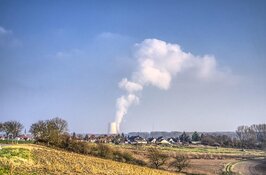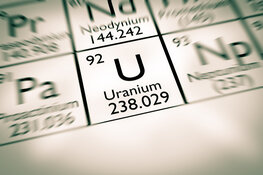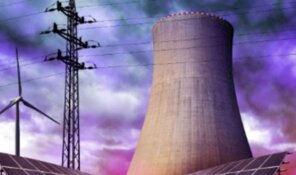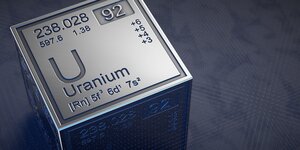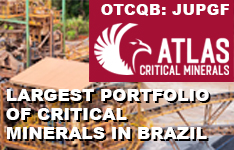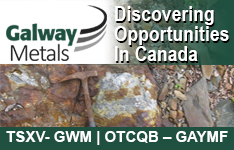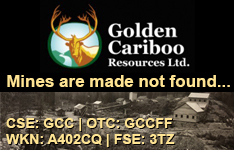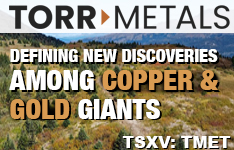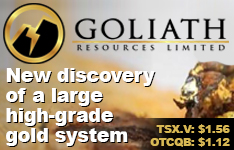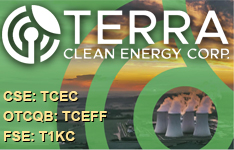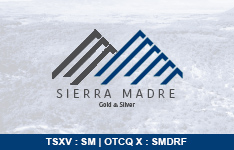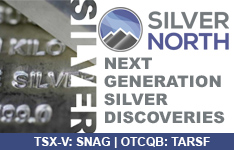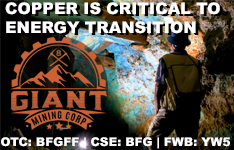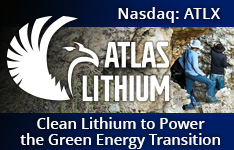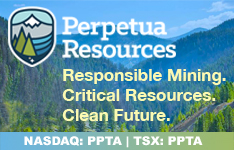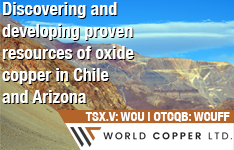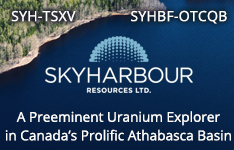Terra Clean Energy Corp. (TCEC:CSE; TCEFF:OTC; C900:FSE) announced the terms for acquiring up to a 100% interest in 75 uranium claims located in Emery County, Utah.
The claims cover nine former uranium mines that have historically produced several hundred thousand tons of ore with grades reaching up to 1% U308, the company said. Visible deposits of uranium, vanadium, copper, and cobalt are present at the surface, with numerous uranium readings up to 21,000 CPS, equating to grades of 0.22% U308.
"One of my stated goals with Terra was to add another low-risk uranium project to the company, and this transaction does just that," President, Chief Executive Officer, and Director Greg Cameron said in a release on September 16. "Having toured the properties with our VP Exploration, it is clear from the moment you arrive you are in a uranium district with many old workings, adits, shafts, and old infrastructure. I am excited to see work begin this fall and believe there to be a clear path to add significant value for our shareholders."
The site is conveniently located near major roads, providing good year-round access, with power and a uranium mill within a 75-mile drive, Terra Clean said.
There is also strong government support for nuclear power and uranium mining projects, with a stated goal to reduce reliance on foreign nuclear fuel, the company said.
A staged earn-in structure will allow the company to optimize its exploration programs, the release noted. The acquisition provides Terra shareholders with exposure to two North American assets, both offering near-surface uranium opportunities in low-risk jurisdictions.
Accelerating Nuclear Power, Uranium Mining
The Green Vein Mesa and Wheal Anne claims provide exposure to uranium projects in the U.S. with excellent potential in a historically significant uranium district. Terra said it strategically decided to acquire these claims due to the belief that more minable uranium is present.
The claims have a history of production and are ideally located near main and secondary roads, with access to power and water sources. Historically, mining operations focused on ore found at or near the surface, where oxidation led to the formation of various secondary uranium minerals. Recent policies enacted by the Trump Administration are designed to accelerate nuclear power and uranium mining activity in the country.
"This initial project in San Rafael Swell offers significant upside as it is clear that these old mines were abandoned in the 1970s due to a uranium market collapse, not because they ran out of uranium to mine," Cameron said.
Vice President Exploration Trevor Perkins added, "We believe strongly that we can expand on the previous work through modern exploration technologies like 3D modeling."
The San Rafael Swell is a large, uplifted, doubly-plunging anticline in east-central Utah, contrasting with the surrounding flat-lying rocks of the Colorado Plateau, a significant uranium mining district in the Western United States, the company said. Historical uranium production occurred in the region from the late 1940s into the 1970s, with no significant work completed in the past 50 years.
The rocks in the San Rafael Swell are predominantly sedimentary (Pennsylvanian through Cretaceous), including Triassic and Jurassic formations known to host uranium. The project area is underlain by Triassic-aged sedimentary rocks of the Moenkopi and Chinle formations. The Chinle outcrops in a continuous belt around the San Rafael Swell and on isolated buttes through the center of the swell.
It is widely believed that volcanic ash is the source of uranium for many deposits in the swell, Terra Clean noted. All existing mines and prospects in the Chinle are in the lower, bentonitic part of the Chinle in channel-fill sandstone and surrounding siltstones of the lower Chinle Formation. In the Green Vein Mesa area, these occur as scour channel fill at the contact with the underlying Moenkopi Formation.
Details of the Claims
The project is divided into two claim groups situated 10 kilometers apart. The Wheal Anne Claim Group, located to the southwest, spans approximately 130 hectares and includes the former Lucky Strike Mine along with associated uranium occurrences. Discovered in 1949, the Lucky Strike Mine yielded over 10,000 tons of ore with grades of 0.22% U3O8 and 0.09% V2O5.
The Green Vein Mesa Claim Group, positioned to the northeast, covers around 300 hectares and includes the former Payday Mine, Hertz Mine, and the Green Vein group of mines. While specific production figures for these mines are unavailable, the Hertz Mine reportedly had local samples with up to 1% U3O8.
In order to acquire the claims, Terra Clean must complete various cash payments, share issuances, and exploration expenditures, starting with US$30,000 in cash payments at the execution of the agreements, 750,000 shares in the first five business days of the agreements, and US$150,000 in exploration expenditures total at both projects to earn the first stage of 20% interest in both.
The agreements to acquire an interest in the Wheal Anne and the Green Vein Mesa claims remain subject to the receipt of all regulatory approvals, including the approval of the Canadian Securities Exchange.
All securities issued in connection with these agreements would be subject to a four-month plus one-day hold period from the date of issuance in accordance with applicable securities laws.
Experts Emphasize Exploration
Several analysts and commentators have expressed positive views on Terra Clean Energy Corp. and its efforts at the South Falcon East uranium project, especially considering the company's recent and planned drilling activities.
On April 7, Fundamental Research Corp. emphasized the outcomes of the company's winter drilling campaign, noting, "Six out of seven holes of a recently completed drill program by Terra Clean Energy Corp. at the South Falcon East project intersected uranium mineralization. The company is planning a summer drill program."
Following this, HoldCo Markets issued a research note on April 30, expressing optimism about the company's valuation prospects, stating, "Given Terra Clean Energy Corp.'s robust near-term drilling plans, the risk remains on the upside for a material valuation rerate . . . seeing that the deposit remains open in numerous directions, additional work spend may lead to an increase in both grade and resource size."
Adding further insight, Jeff Clark of TheGoldAdvisor.com wrote on May 1, "Terra Clean Energy Corp.'s 2,500-meter summer drill program at South Falcon East will test an area highlighted in winter drilling that is defined by an intersection of three prospective alteration types . . . the program budget for the summer field season on the project, including drilling, is CA$2 million."
The Catalyst: Rise in Demand Predicted
The uranium sector is currently navigating intricate supply-demand dynamics shaped by evolving policy priorities and structural demand growth. According to the World Nuclear Association, global mine production fulfills about 90% of uranium needs, with the rest coming from secondary sources such as recycled material and stockpiles.
Although spot uranium prices saw a recovery between 2003 and 2009, they have remained low since then. The association noted that "the price cannot indefinitely stay below the cost of production." The association's 2023 Nuclear Fuel Report anticipates a 28% rise in uranium demand from 2023 to 2030, driven by the long-term nature of nuclear power generation, which is less affected by short-term economic changes.
Crux Investor highlighted ongoing challenges in the sector. Although political support for nuclear energy has improved regulatory conditions, uranium prices remain below the levels typically required to incentivize new production.
Prices near US$65 per pound fall short of the US$100 threshold often cited as necessary for new supply to come online. Term contracts are being signed at prices above US$80 per pound, reflecting utilities’ willingness to secure supply, but long-term production constraints remain, particularly as high-grade reserves are depleted and processing infrastructure remains limited.
The report also pointed to rising interest in domestic uranium supply within North America, driven by geopolitical considerations. “Domestic uranium commands premium pricing due to supply chain security concerns,” Crux stated, highlighting the strategic advantage of U.S.-based sources. Utilities are increasingly focused on securing reliable domestic supply, particularly as demand from data centers and national infrastructure expands.
 Streetwise Ownership Overview*
Streetwise Ownership Overview*
Terra Clean Energy Corp. (TCEC:CSE; TCEFF:OTC; C900:FSE)
Uranium giant Cameco Corp. (CCO:TSX; CCJ:NYSE) shares spiked nearly 10% to a record high, adding about US$4.6 billion in market value in a single session, Jeff Peterson reported for NAI 500 on September 17. The move caps a roughly 60% year-to-date run, driven by expectations that the United States will expand a domestic nuclear fuel stockpile.
"The rally is not just headline noise," Peterson wrote. "It plugs into a larger recalibration of nuclear supply chains away from Russia and toward North American conversion, enrichment, and mining. But price is not the same as proof. For investors, the key is whether policy, contracts, and new supply timelines line up with the enthusiasm now reflected in equity prices."
Ownership and Share Structure
Insiders and management own about 12% of the company and institutions owned 20%, as of September 18, the company said. The rest is in retail.
Terra Clean Energy has 39.6 million outstanding shares and its market cap is CA$4.89 million. Its 52-week range is CA$0.07–0.36 per share.
| Want to be the first to know about interesting Uranium investment ideas? Sign up to receive the FREE Streetwise Reports' newsletter. | Subscribe |
Important Disclosures:
- Terra Clean Energy Corp. is a billboard sponsor of Streetwise Reports and pays SWR a monthly sponsorship fee between US$3,000 and US$6,000.
- As of the date of this article, officers and/or employees of Streetwise Reports LLC (including members of their household) own securities of Terra Clean Energy Corp. and Cameco Corp.
- Steve Sobek wrote this article for Streetwise Reports LLC and provides services to Streetwise Reports as an employee.
- This article does not constitute investment advice and is not a solicitation for any investment. Streetwise Reports does not render general or specific investment advice and the information on Streetwise Reports should not be considered a recommendation to buy or sell any security. Each reader is encouraged to consult with his or her personal financial adviser and perform their own comprehensive investment research. By opening this page, each reader accepts and agrees to Streetwise Reports' terms of use and full legal disclaimer. Streetwise Reports does not endorse or recommend the business, products, services or securities of any company.
For additional disclosures, please click here.


